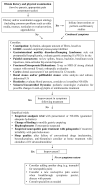A Pragmatic Approach to Assessment of Chronic and Recurrent Pain in Children with Severe Neurologic Impairment
- PMID: 35053670
- PMCID: PMC8774866
- DOI: 10.3390/children9010045
A Pragmatic Approach to Assessment of Chronic and Recurrent Pain in Children with Severe Neurologic Impairment
Abstract
The term "severe neurologic impairment" (SNI) is used to describe a group of disorders of the central nervous system which arise in childhood, resulting in motor impairment, cognitive impairment and medical complexity. As a result, much assistance is required with activities of daily living. Since these patients are often unable to self-report pain, or they may exhibit uncommon behaviors when suffering, pain manifestations may go unrecognized. In this article, the basic principles of how to approach pain in children with SNI are discussed.
Keywords: pain; severe neurologic impairment.
Conflict of interest statement
The authors declare no conflict of interest.
Figures


References
LinkOut - more resources
Full Text Sources
Research Materials

